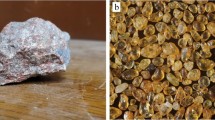Abstract
The Albany Research Center (ARC) conducted studies of mechanical activation by conventional and ultrafine grinding techniques to enhance olivine reactivity in mineral carbonation reactions. Activated olivine is one of several solid feed materials used at ARC in reactions with carbon dioxide toform carbonate minerals. This paper compares grinding techniques via energy demand data and product characteristics, including particle size distributions, surface areas, full-width-at-half-maximum (FWHM) XRD analyses, and particle morphology by SEM analyses. Reactivity was calculated by percent conversion to carbonate in subsequent carbonation tests. Particle size reduction has the greatest impact on reactivity, and wet grinding is more energy efficient than dry grinding. Large additional inputs of energy to increase surface area or reduce crystallinity do not result in proportional improvements in reactivity.
Similar content being viewed by others
References
Benjamin, J.S., and Volin, T.E., 1974, “The mechanism of mechanical alloying,” Metallurgical Trans., Vol. 5, pp. 1929–1934.
Bond, F.C., 1985, “Testing and calculations,” in Sec. 3A, General Aspects of Comminution, SME Mineral Processing Handbook, Weiss, N.L., ed., Society of Mining Engineers of the American Institute of Mining, Metallurgical, and Petroleum Engineers, Inc., New York, pp. 3A–16–3A–27.
Guerrero-Paz, J., and Jaramillo-Vigueras, D., 1998, “Particle size evolution in Cu-15%AI mechanically alloyed,” NanoStructured Materials, Vol. 10, pp. 1209–1222.
Lin, I.J., Nadiv, S., and Grodzian, D.J.M., 1975, “Changes in the state of solids and mechano-chemical reactions in prolonged comminution processes,” Minerals Sci. Eng., Vol. 7, pp. 313–336.
McKelvy, M.J., Chizmeshya, A.V.G., Bearat, H., Sharma, R., and Carpenter, R.W., 2001, “Developing mechanistic understanding of C02 mineral sequestration reaction processes,” Proc. 26th International Tech. Conference on Coal Utilization & Fuel Systems, Clearwater, Florida, March 5–8, 2001, pp. 777–788.
O’Connor, W.K., Dahlin, D.C., Rush, G.E., Dahlin, C.L, and Collins, W.K., 2001, “Carbon dioxide sequestration by direct mineral carbonation: process mineralogy of feed and products,” Preprint No. 01.009, presented at the SME Annual Meeting, Feb. 26–28, 2001, Denver, Colorado, 9 pp.
O’Connor, W.K., Dahlin, D.C., Nilsen, D.N., Gerdemann, S.J., Rush, G.E., Walters, R.P., and Turner, P.C., 2001, “Research status on the sequestration of carbon dioxide by direct aqueous mineral carbonation,” Paper 35-1, Proc. 18th Annual Inter. Pittsburgh Coal Conference, Newcastle, NSW, Australia, December 3–7, 2001, 11 p.
O’Connor, W.K., Dahlin, D.C., Nilsen, D.N., Gerdemann, S.J., Rush, G.E., Penner, L.R., Walters, R.P., and Turner, P.C., 2002, “Continuing studies on direct aqueous mineral carbonation for C02 sequestration,” Proc. 27th International Tech. Conference on Coal Utilization & Fuel Systems, Clearwater, Florida, March 4–7, 2002.
Tromans, D., and Meech, J.A., 2001, “Enhanced dissolution of minerals: Stored energy, amorphism and mechanical activation,” Minerals Engineering, Vol. 14, pp. 1359–1377.
Tromans, D., and Meech, J.A., 2002, “Enhanced dissolution of minerals: Conjoint effects of particle size and microtopography,” Minerals Engineering, Vol. 15, pp. 263–269.
Zhang, Q., Sugiyama, K., and Saito, F., 1997, “Enhancement of acid extraction of magnesium and silicon from serpentine by mechanochemical treatment,” Hydrometallurgy, Vol. 45, pp. 323–331.
Author information
Authors and Affiliations
Additional information
Preprint number 04-093, presented at the SME Annual Meeting, Feb. 23–25, 2004, Denver, Colorado. Discussion of this peer-reviewed and approved paper is invited and must be submitted to SME Publications Dept. prior to Feb. 28, 2006.
Rights and permissions
About this article
Cite this article
Summers, C.A., Dahlin, D.C., Rush, G.E. et al. Grinding methods to enhance the reactivity of olivine. Mining, Metallurgy & Exploration 22, 140–144 (2005). https://doi.org/10.1007/BF03403128
Revised:
Accepted:
Published:
Issue Date:
DOI: https://doi.org/10.1007/BF03403128




